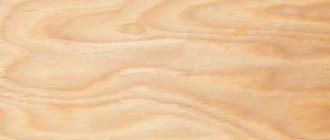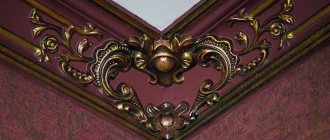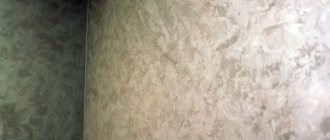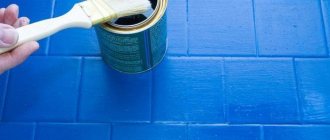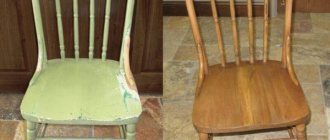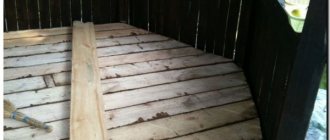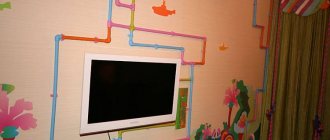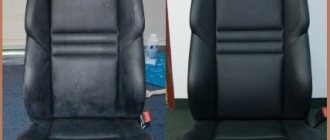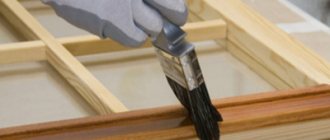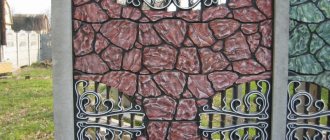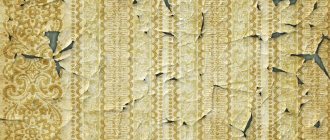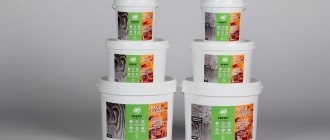Polyurethane is a fairly common finishing material, from which all kinds of moldings, baseboards and other decorative products that look like stucco are made. However, for all these decorative elements to be truly attractive and practical, they need to be painted.
As a rule, this procedure causes difficulties for novice craftsmen, which are associated with the choice of the coloring composition and the technology for its application, so next we will look at how and with what to paint polyurethane stucco molding.
Painting polyurethane stucco
Why paint polyurethane
Before moving on to choosing paints and applying them, you should figure out whether this procedure is so important that you bother with it?
Experts have several arguments in this regard:
- Of course, polyurethane itself looks good, however, it attracts dust and dirt well, which is difficult to remove from porous stucco. Caring for a painted surface is much easier.
- If we are talking about baseboards and moldings, then no matter how carefully their installation is carried out, there will definitely remain joints between the panels, especially at the corners. You can get rid of them using putty, which is hidden under a layer of paint.
- And the last thing is, of course, the decorative properties of the painted surface. Finished stucco looks much more attractive, not to mention the ability to give the product any shade or simply paint it, for example, bronze or gold.
These arguments are quite enough to make the right decision in favor of painting.
What is the best way to paint plaster figures?
Acrylic, water-dispersion and water-emulsion paints are well suited for painting gypsum products. The color is chosen based on the features of the figurine or the interior. Painting is done with a spray, brush or cotton (gauze) swab.
Interesting materials:
Where can I get materials to build a house in Skyrim? Where can I get the details to pay the state fee? Where can I get a certificate stating that I am a pensioner? Where can I get reeds in Medieval Dynasty? Where is Win 32? Where to pick up a car from the GTA 5 impound lot? Where can I ask an anonymous question? Where to fill out an income tax return? Where can I fill up with good gasoline? Where is it forbidden to wear a burqa?
Paint selection
The choice of dye for polyurethane should be approached very responsibly, since the material dissolves when white spirit or other similar solvents come into contact with it. Therefore, paints must be water-based.
These include the following types of compositions:
- Acrylic;
- Latex;
- Silicone;
- Mosaic.
Now let’s take a closer look at the features and properties of these dyes.
Acrylic paint (do not be confused - these are not fire-retardant paints for metal Polistil)
Acrylic coatings
Most often, acrylic paint, which is based on acrylic resins, is used for finishing polyurethane.
The high popularity of this coating is due to the following reasons:
- The paint is absolutely odorless and harmless to the body, like all other water-dispersed compositions. Therefore, you can paint in residential areas without fear for your health.
- The coating is matte, which allows you to give the finished surface the appearance of gypsum stucco.
- This polyurethane paint withstands wet cleaning well.
- It is resistant to temperature changes.
- Forms a coating that is quite resistant to mechanical stress.
- It is durable.
- Low price compared to other types of water-dispersion compositions.
Thus, when choosing what to paint polyurethane foam with, you can easily opt for acrylic paint.
Advice! Since polyurethane is a flammable material, it is often coated with fire-retardant acrylic paints. However, in order to achieve reliable passive fire safety in a home, it is necessary to treat other finishing surfaces, as well as all metal communications, with fire retardant compounds. For the latter, you can use special fire-retardant paints for metal Polistil.
Latex paint
Latex paint
Latex coatings also have excellent performance qualities; in particular, they are distinguished by:
- Moisture resistance – the coating is not afraid of direct contact with water.
- High wear resistance.
- Looks attractive - unlike acrylic coating, it can form a glossy surface.
Silicone paint
Silicone
Silicone paint for polyurethane stucco has the best performance qualities. Its main advantage is that it is endowed with dirt-repellent properties, so it practically does not become dirty. In addition, the composition has all the advantages of both materials discussed above.
The only disadvantage of silicone coating is its high cost.
Materials for making molding
A wide variety of materials are used to make moldings, among which the following are popular:
- marble;
- gypsum;
- metal;
- polystyrene;
- tree.
Each type of material has its own characteristics. Gypsum is a natural raw material, but you need to take into account that it crumbles and is susceptible to moisture. Also, to install plaster stucco, you need to contact a specialist, which will significantly affect the cost.
Polyurethane and polystyrene are types of foam. The first consists of almost imperceptible granules, the second - of more pronounced ones. These materials have an advantage in price; you can install them yourself. When choosing any of the options, you should pay attention to the fact that it does not crumble and has a uniform surface. Polyurethane is the most used material. It can be easily painted in any shade suitable for the interior of the room.
Wood is often used in the manufacture of moldings. The most popular breeds used to create decorative elements:
- poplar;
- alder;
- spruce;
- oak;
- Red tree;
- yew;
- maple.
Wood will help create a classic aristocratic style; this type of material is durable and quite easy to process. But it has a high cost and also does not have sufficient moisture resistance.
Colored moldings will add originality to the design of the room. With their help, you can reproduce the structure of natural wood, as well as plant and floral motifs, and create a variety of geometric patterns. The correctly chosen color of the product will highlight the design of the room. In addition, painting polyurethane molding is not difficult.
In order for the molding to have an attractive appearance and good preservation, it must be painted. This prevents dirt from clogging into the pores, and the product itself becomes easier to clean. If necessary, it will not be difficult to wash it with any detergent composition. Even if the desired color is white, it is still necessary to paint the molding.
Necessary materials for the process:
- Paint for this product.
- Polyurethane moldings.
- Decorative plaster.
- Acrylic based primer.
- Small brush and spatula.
Painting technology
As a rule, the most questions arise when painting polyurethane moldings and ceiling plinths yourself.
There are two options for doing this job:
- Before installation - this option is, of course, much simpler than finishing after installation. However, in this case it will not be possible to hide the gaps at the joints.
- After installation, this process is more complex, but it allows you to pre-putty and obtain a continuous surface.
The second option is often preferred, so we will consider it.
Puttying polyurethane stucco
Preparation
Before painting polyurethane stucco, you should prepare the base.
The work is performed in this order:
- The surface must be thoroughly wiped from dust.
- Next, the cracks are sealed with putty. In this case, you should also pay attention to the gaps between the wall and the molding being finished.
- Then all surfaces adjacent to the molding must be protected from paint contamination; for this you can use masking tape. Furniture and floors should be covered with oilcloth.
- The final stage of preparation is to coat the polyurethane with a primer, which will improve adhesion.
In the photo - painting a polyurethane baseboard with a brush
Painting
After preparing the surface, you can begin painting. For these purposes, it is best to use an ordinary brush.
The instructions look like this:
- The first step is to prepare the paint - stir the composition and, if necessary, add color.
- The coating is then applied in an even, thin layer.
- After the first layer of paint has dried, the procedure can be repeated again.
Advice! As a rule, painting polyurethane moldings is part of the complete finishing of the room. In this case, it is necessary to pay attention to the quality of paint compositions for other surfaces so that you do not have to return to this procedure ahead of time. This is especially true for metal communications, which are susceptible to corrosion, so you need to use reliable coatings for them, such as Zinga electrically conductive paint.
Gilding, silvering, bronzed
Stucco molding covered with bronze, gold or silver paint looks solemn and brings a touch of aristocracy and wealth to the interior. In the traditional gilding technique, thin sheets of gold leaf (or gold leaf) are used. An alternative option is inexpensive metallic spray paint.
Photo: gilding
Performing classic gilding:
- Chips and cracks are removed from the working surface.
- Sanding stucco with a special machine or sandpaper.
- Dust is removed with a brush or vacuum cleaner.
- Treatment of stucco with an industrial primer or glue.
- Gold plating paste, previously mixed with glue, is applied to the fully prepared product.
- Gold leaf or gold leaf is applied with a soft hair brush. Carefully, so as not to tear, it is smoothed onto the gypsum stone, repeating all its relief curves.
It is much easier to work with metallic acrylic spray paints:
- dry quickly;
- do not have a strong odor;
- fit easily onto the base.
Primer and varnish are selected taking into account the recommendations of the paint manufacturer.
Painting compositions with a bronze effect are slightly heated, then applied to the primer. Powdered bronze is diluted with varnish, and the resulting mixture is applied to the stucco molding using a brush.
Step-by-step instruction:
- Cleaning, removing dust, priming the gypsum base.
- Painting: 1st layer – application of the lightest shade of a liquid consistency, which is used to paint the entire surface (after the color has dried, the convex elements are sanded and dusted off); 2nd layer – painting with a thicker composition with the addition of bronze powder, carefully painting the recesses; The 3rd layer is the use of paint, which is diluted with turpentine and beeswax is added, giving the effect of a metallic shine. Imitation of patina is achieved by coating the convex areas of the color in combination with chromium oxide or a mixture of bronze and graphite. The second method is to apply a special liquid prepared from silver nitrate (10 g), water (300 g) and vinegar (100 g) over the varnished layer containing bronze dust. After an oxidation reaction, a patina forms on the bronze.
- The painted and patinated product is rubbed with a solution made from wax and turpentine until the product is no longer absorbed.
- The final stage is wiping the surface with velvet cloth.
Using metallic aerosol greatly simplifies the work:
- paint is sprayed over the primed surface;
- unpainted areas are painted on with a thin squirrel brush;
- gild individual sections of the pattern or the edges of convex elements.
Places that will not be finished with gold paint are isolated with masking tape or portable cardboard screens.
Conclusion
Finishing polyurethane stucco is not difficult. The main thing is to choose the right paint, made exclusively with water, and adhere to the above-described technology for its application. Even masters who have never done anything like this are quite capable of doing this work.
For more information on this topic, watch the video in this article.
We offer water-based paints for supply - quick-drying non-stick coating PPU-1, F-RA, F-RDS
.
Scope of application:
intended for covering models made of foamed polystyrene or polymethyl methacrylate (copolymer).
Patination
Photo: patina
The effect of antique stucco is obtained by tinting the gypsum with primer or natural drying oil, which gives the product a slight yellowish tint. After this, paint is applied with fillet brushes. Sunken areas are worked with thin brushes with soft bristles.
Imitation of a transparent paint layer is achieved by varying the thickness of the paint layer in different areas of the stucco decoration. Thick layers are created by tamponing, and thin layers by shading, using a brush with shortened, harsh hair.
Patination is done with a grinder, sandpaper or wire brush. The painted bumps are sanded, forming “scuffs”. Finishing using this technique looks harmonious on gypsum stone painted to look like wood (brushing) or treated with metallic.
Non-stick coatings have certain properties
- drying of the first layer 30-40 minutes (t > 30°C);
- Application options: watering from a container (ladle, bucket), brushing, dipping;
- thin layer: first - 0.3-0.5 mm, second - 0.5-1 mm;
- In addition to the necessary gas permeability, coatings have the ability to absorb the liquid phase (a product of the destruction of polystyrene), which greatly helps to eliminate carbon defects.
- if all technological conditions are met, it does not form a burn.
For large and medium-sized steel workpieces, F-RDS
, having higher fire resistance. Paints are supplied as powder concentrates.
Non-stick paint has the above properties and has the characteristics inherent in high-quality coatings:
- excellent
hiding power; - good
grip on any surface; - smooth coating
- without cracks, cavities and other defects after drying; - ultra-high
gas permeability
PPU-1
,
medium - F-RDS and F-RA
; - operating temperature range PPU-1 and F-RA up to 1600 o C, F-RDS - up to 2100 o C.
Features of use and storage of PPU-1, F-RDS
It is permissible to store diluted non-stick high pressure paint at subzero temperatures (up to -50°C). Freezing and defrosting do not have a negative impact on the technological properties of the coating.
The principle of preparation and use of powder concentrate is similar to analogues of non-stick paints. When using a concentrate weighing 1 kg, 1.5-2 kg of finished coating is obtained.
It should be noted that a high degree of homogeneity of ready-to-use paint, as a result of the mixing process, is one of the most important conditions contributing to the necessary quality indicators of the coating, therefore, even after preparing the paint, the material must be stirred periodically during the work shift. A visual sign of a high-quality prepared material is the absence of paint dripping from the model after its application. However, the applied layer may be too thick, which will lead to high paint consumption.
Coating components are environmentally friendly.
Today, foamed polyurethane is actively used for the production of various types of decor. The decor is used to decorate residential premises.
Its advantages are clear - in comparison with gypsum analogues, polyurethane foam weighs almost nothing, but from a design point of view it has pronounced stylistic qualities.
However, we should not forget that in living conditions there is a large amount of dust that settles on decorative items made from the said material.
If you use it unpainted, it will quickly lose its attractive qualities.
Methods
Coloring does not require any special skills. But the technology directly depends on at what stage of the finishing work you decided to do this. Read a separate article about how to make a corner on a ceiling plinth using a miter box.
Painting foam baseboards with a brush
To begin, cover the floor with newspapers, paper or film to prevent stains . When the walls have already been decorated, it is advisable to protect them from paint. Apply masking tape along the line of the installed molding, remove it when the paint on the baseboard has already dried.
This video will show you how to paint a ceiling plinth using tape.
Professionals recommend painting ceiling plinths of various textures in several layers , this will give a better look and make the job perfect.
Diamond IMPORTANT! Water-based paint is considered an excellent paint; it is easy to apply and easy to wash and clean. Dries from 6 to 48 hours.
There are two ways to paint skirting boards:
- attach masking tape along the baguette line. It can be easily removed and leaves no traces;
- painting baseboards with paper: Keep thick paper or cardboard at the border from the ceiling to the walls. Insert it into the hole between the ceiling and the baseboard and begin work, simultaneously moving the paper in the direction of painting. This simple method will help protect walls from paint drips and smudges.
How to prepare polyurethane stucco for painting?
Strictly speaking, the following technique is suitable for any decor made of polyurethane foam. Initially, it is necessary to install the decor in a place where it will be permanently present.
Many people believe that the easiest way is to paint the stucco molding first and only then install it on the ceiling using glue. This is wrong. After all, black stripes will remain at the joints, which will ruin the entire appearance.
The preparation process is as follows:
- stucco molding is installed;
- a primer is applied to the joints;
- the adjacent ceiling and walls are protected;
- stucco molding is thoroughly cleaned;
- primer is applied under the paint (for better adhesion);
- Painting occurs using an ordinary brush.
However, for the most positive effect, you need to choose the right paint. After all, foamed polyurethane cannot be painted with any kind of paint. The market offers several options.
Each of them is suitable for use to some extent. Read below about which one is best to choose.
What material is suitable?
The construction market offers a wide range of types of painting products . Each has its own advantages and disadvantages, so you yourself will find a solution that is perfect for your conditions.
Watch this video for a master class on painting ceiling plinths with different effects.
We present to you the types of skirting boards for painting:
- MDF. MDF plinth is considered an environmentally friendly and safe material; it is quite close to wood. Such panels will withstand significant changes without damaging the structure. The panels are mounted with your own hands using a clip. The price segment is much lower than that of wood, this determines the demand for such skirting boards. This type of plinth has a ready-made base for painting. All you have to do is install and paint it the color you want. A significant advantage is that such panels have a large selection of sizes and configurations, so they can be selected for almost all interiors.
- Fiberboard skirting boards. High-quality and environmentally friendly materials are used in production. The products are excellent at withstanding temperature changes. The price segment is within from 250 to 750 rubles.
- Polyurethane skirting boards. They are environmentally friendly and have no restrictions on use. The material does not burn and does not emit harmful substances into the atmosphere. Will serve you for 25 years. This kind of skirting boards do not absorb moisture. The advantage is that the plinth is able to take the shape you need, providing you with a good appearance of the joints of the walls and floor. In a separate article, you can read more about stucco and plaster.
- Wooden skirting boards. This type can also be painted. Wooden plinth is afraid of moisture. This option cannot be called budgetary; wood prices are quite high. The surface must be sanded.
- Foam skirting boards. The most budget option, at the same time the easiest to use due to its lightness. Can be made in any color and relief. It will also be useful to read the article on installing foam baseboards.
